Page 2779 of 3371
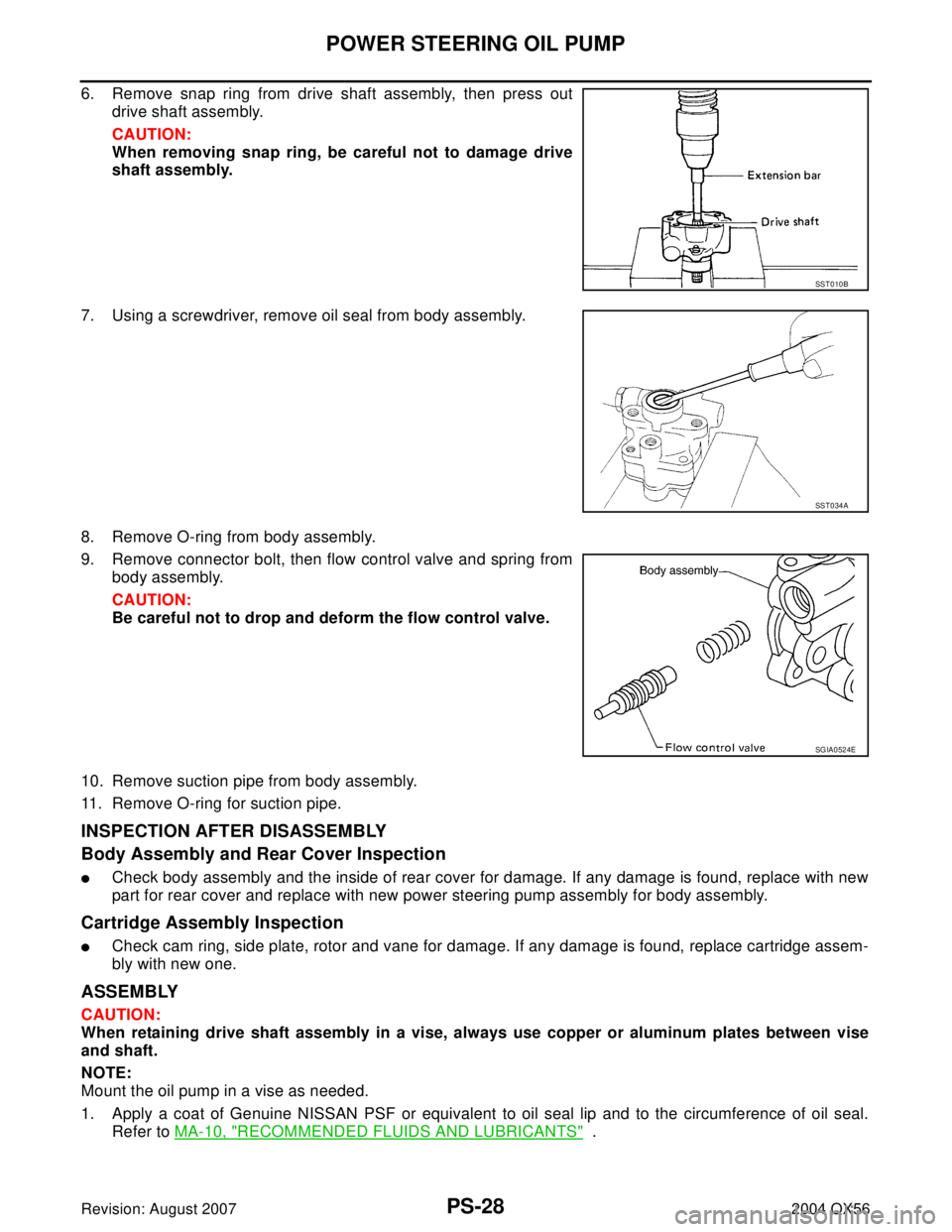
PS-28
POWER STEERING OIL PUMP
Revision: August 20072004 QX56
6. Remove snap ring from drive shaft assembly, then press out
drive shaft assembly.
CAUTION:
When removing snap ring, be careful not to damage drive
shaft assembly.
7. Using a screwdriver, remove oil seal from body assembly.
8. Remove O-ring from body assembly.
9. Remove connector bolt, then flow control valve and spring from
body assembly.
CAUTION:
Be careful not to drop and deform the flow control valve.
10. Remove suction pipe from body assembly.
11. Remove O-ring for suction pipe.
INSPECTION AFTER DISASSEMBLY
Body Assembly and Rear Cover Inspection
�Check body assembly and the inside of rear cover for damage. If any damage is found, replace with new
part for rear cover and replace with new power steering pump assembly for body assembly.
Cartridge Assembly Inspection
�Check cam ring, side plate, rotor and vane for damage. If any damage is found, replace cartridge assem-
bly with new one.
ASSEMBLY
CAUTION:
When retaining drive shaft assembly in a vise, always use copper or aluminum plates between vise
and shaft.
NOTE:
Mount the oil pump in a vise as needed.
1. Apply a coat of Genuine NISSAN PSF or equivalent to oil seal lip and to the circumference of oil seal.
Refer to MA-10, "
RECOMMENDED FLUIDS AND LUBRICANTS" .
SST 0 10 B
SST 0 34 A
SGIA0524E
Page 2786 of 3371
SERVICE DATA AND SPECIFICATIONS (SDS)
PS-35
C
D
E
F
H
I
J
K
L
MA
B
PS
Revision: August 20072004 QX56
Steering GearEGS000NI
Oil PumpEG S0 0 0NJ
Steering FluidEGS000NK
Steering gear modelPR26AM
Rack neutral position, dimension “L” (rack stroke) 85.5 mm (3.36 in)
Rack sliding forceAt the neutral point:
Range within ± 11.5 mm
(±0.453 in) from the neutral
position
(in power ON)Area average value 147 − 211 N (14.99 − 21.52 kg, 33.1 − 47.52 lb)
Allowable variation 98 N (10 kg, 22 lb) or less
Whole area (in power OFF)Peak value 294 N (30.0 kg, 66 lb) or less
Allowable variation 147 N (16 kg, 35 lb) or less
STC0034D
Relief oil pressure
9.0 − 9.8 mPa (91.77 − 99.93 kg/cm2 , 1305.34 − 1421.37 psi)
Fluid capacity
Approx. 1.0 (1-1/8 US qt, 7/8 Imp qt)
Page 2798 of 3371
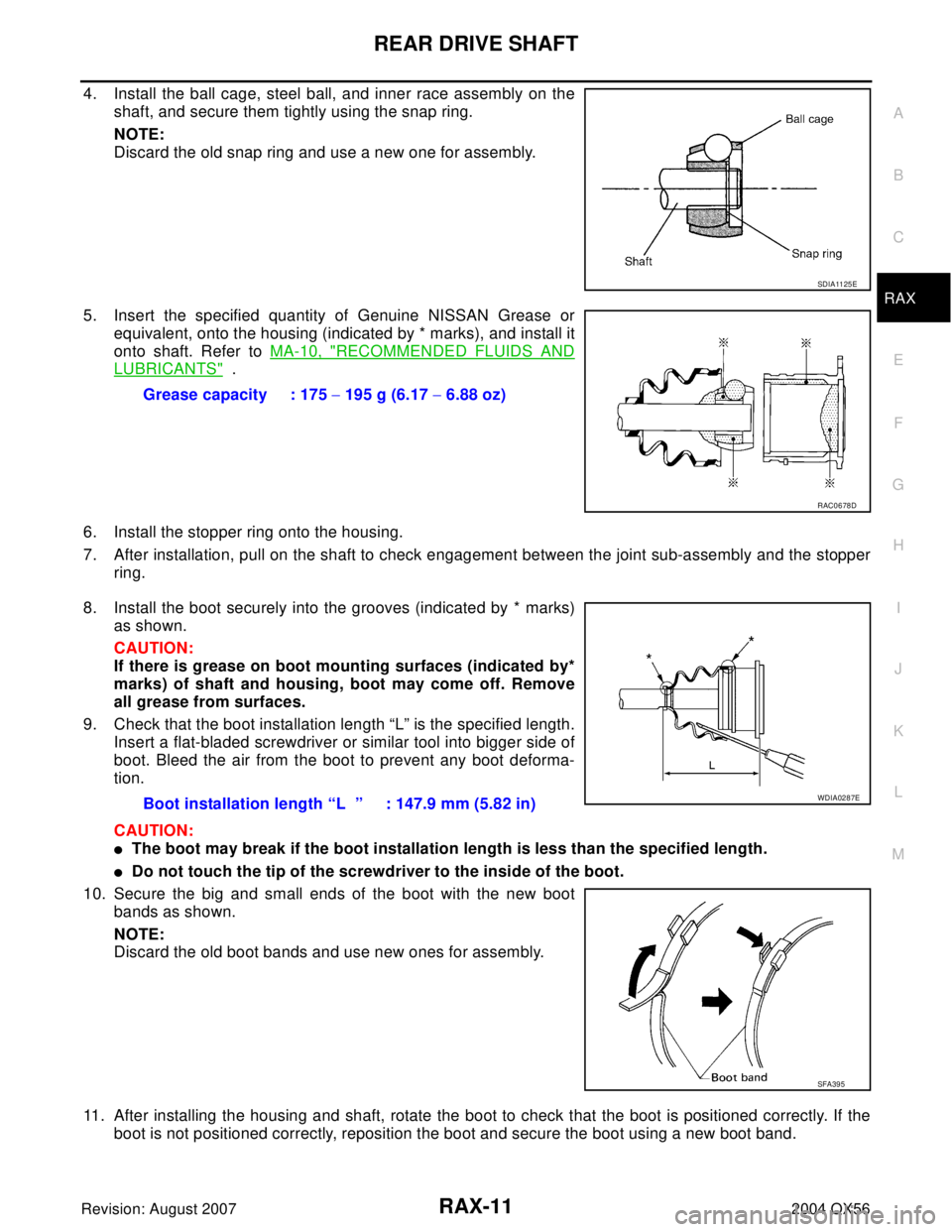
REAR DRIVE SHAFT
RAX-11
C
E
F
G
H
I
J
K
L
MA
B
RAX
Revision: August 20072004 QX56
4. Install the ball cage, steel ball, and inner race assembly on the
shaft, and secure them tightly using the snap ring.
NOTE:
Discard the old snap ring and use a new one for assembly.
5. Insert the specified quantity of Genuine NISSAN Grease or
equivalent, onto the housing (indicated by * marks), and install it
onto shaft. Refer to MA-10, "
RECOMMENDED FLUIDS AND
LUBRICANTS" .
6. Install the stopper ring onto the housing.
7. After installation, pull on the shaft to check engagement between the joint sub-assembly and the stopper
ring.
8. Install the boot securely into the grooves (indicated by * marks)
as shown.
CAUTION:
If there is grease on boot mounting surfaces (indicated by*
marks) of shaft and housing, boot may come off. Remove
all grease from surfaces.
9. Check that the boot installation length “L” is the specified length.
Insert a flat-bladed screwdriver or similar tool into bigger side of
boot. Bleed the air from the boot to prevent any boot deforma-
tion.
CAUTION:
�The boot may break if the boot installation length is less than the specified length.
�Do not touch the tip of the screwdriver to the inside of the boot.
10. Secure the big and small ends of the boot with the new boot
bands as shown.
NOTE:
Discard the old boot bands and use new ones for assembly.
11. After installing the housing and shaft, rotate the boot to check that the boot is positioned correctly. If the
boot is not positioned correctly, reposition the boot and secure the boot using a new boot band.
SDIA11 25 E
Grease capacity : 175 − 195 g (6.17 − 6.88 oz)
RAC0678D
Boot installation length “L ” : 147.9 mm (5.82 in)WDIA0287E
SFA39 5
Page 2799 of 3371
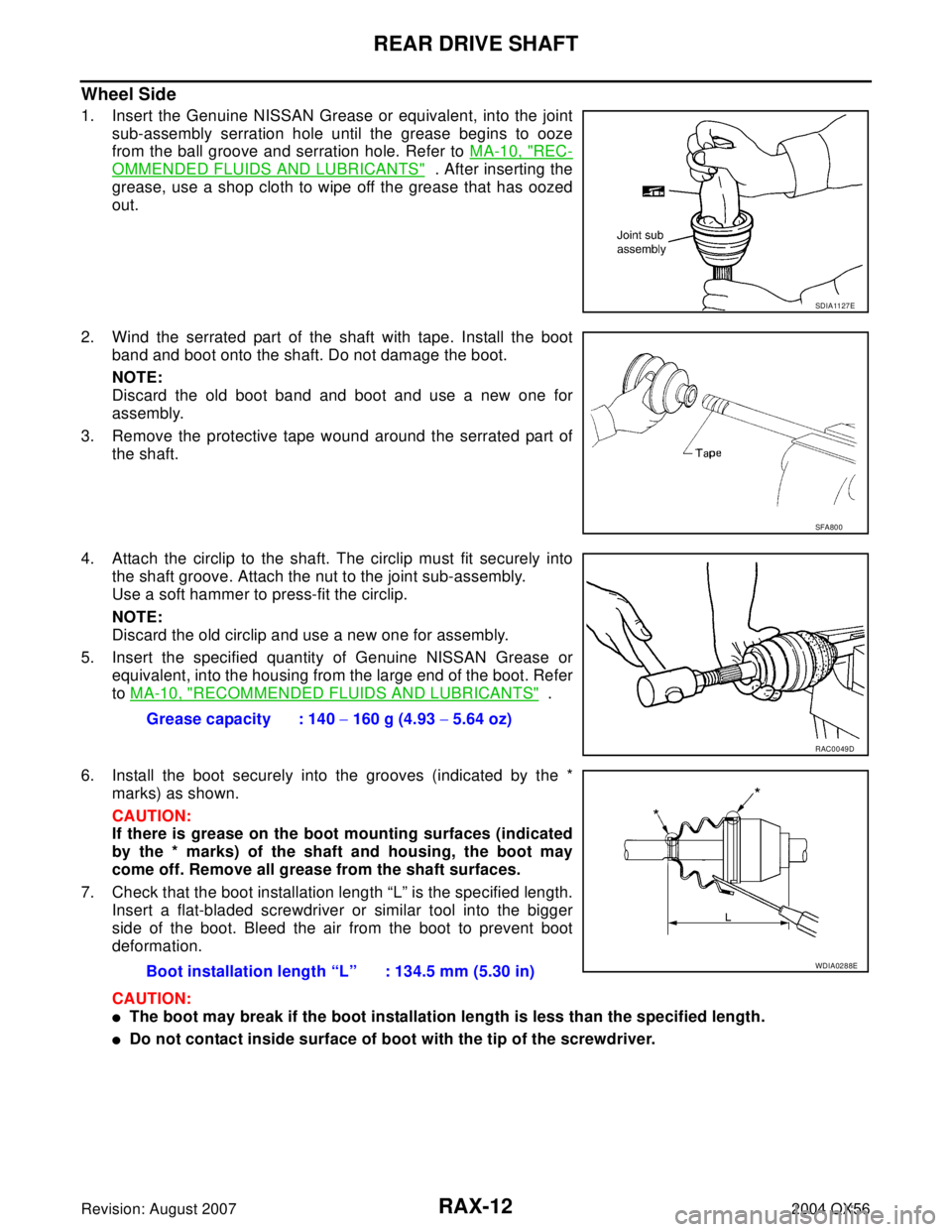
RAX-12
REAR DRIVE SHAFT
Revision: August 20072004 QX56
Wheel Side
1. Insert the Genuine NISSAN Grease or equivalent, into the joint
sub-assembly serration hole until the grease begins to ooze
from the ball groove and serration hole. Refer to MA-10, "
REC-
OMMENDED FLUIDS AND LUBRICANTS" . After inserting the
grease, use a shop cloth to wipe off the grease that has oozed
out.
2. Wind the serrated part of the shaft with tape. Install the boot
band and boot onto the shaft. Do not damage the boot.
NOTE:
Discard the old boot band and boot and use a new one for
assembly.
3. Remove the protective tape wound around the serrated part of
the shaft.
4. Attach the circlip to the shaft. The circlip must fit securely into
the shaft groove. Attach the nut to the joint sub-assembly.
Use a soft hammer to press-fit the circlip.
NOTE:
Discard the old circlip and use a new one for assembly.
5. Insert the specified quantity of Genuine NISSAN Grease or
equivalent, into the housing from the large end of the boot. Refer
to MA-10, "
RECOMMENDED FLUIDS AND LUBRICANTS" .
6. Install the boot securely into the grooves (indicated by the *
marks) as shown.
CAUTION:
If there is grease on the boot mounting surfaces (indicated
by the * marks) of the shaft and housing, the boot may
come off. Remove all grease from the shaft surfaces.
7. Check that the boot installation length “L” is the specified length.
Insert a flat-bladed screwdriver or similar tool into the bigger
side of the boot. Bleed the air from the boot to prevent boot
deformation.
CAUTION:
�The boot may break if the boot installation length is less than the specified length.
�Do not contact inside surface of boot with the tip of the screwdriver.
SDIA11 27 E
SFA80 0
Grease capacity : 140 − 160 g (4.93 − 5.64 oz)
RAC0049D
Boot installation length “L” : 134.5 mm (5.30 in)WDIA0288E
Page 2836 of 3371
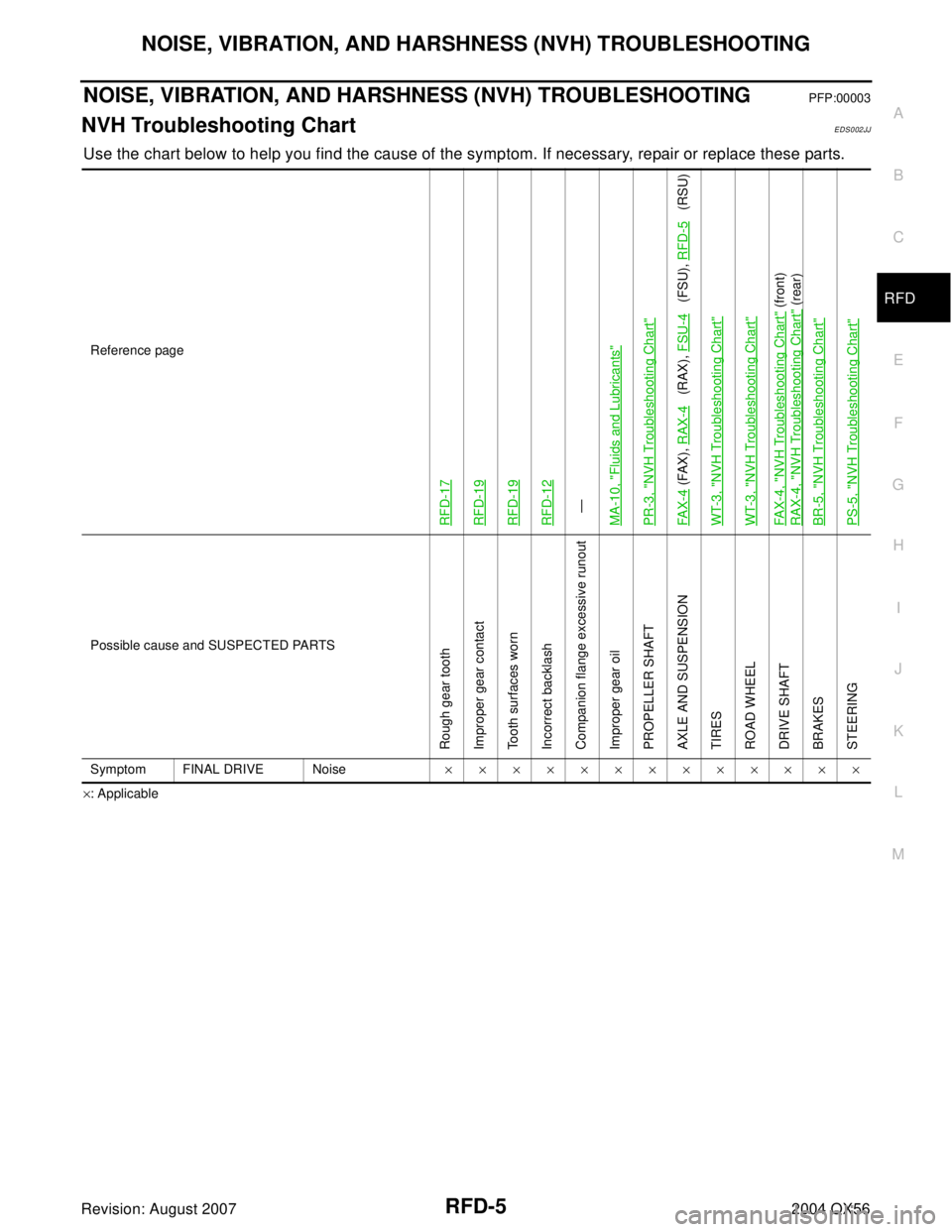
NOISE, VIBRATION, AND HARSHNESS (NVH) TROUBLESHOOTING
RFD-5
C
E
F
G
H
I
J
K
L
MA
B
RFD
Revision: August 20072004 QX56
NOISE, VIBRATION, AND HARSHNESS (NVH) TROUBLESHOOTINGPFP:00003
NVH Troubleshooting ChartEDS002JJ
Use the chart below to help you find the cause of the symptom. If necessary, repair or replace these parts.
×: Applicable Reference page
RFD-17RFD-19RFD-19RFD-12—
MA-10, "
Fluids and Lubricants
"
PR-3, "
NVH Troubleshooting Chart
"
FA X - 4
(FAX), RAX-4
(RAX), FSU-4
(FSU), RFD-5
(RSU)
WT-3, "
NVH Troubleshooting Chart
"
WT-3, "
NVH Troubleshooting Chart
"
FA X - 4 , "
NVH Troubleshooting Chart
" (front)
RAX-4, "
NVH Troubleshooting Chart
" (rear)
BR-5, "
NVH Troubleshooting Chart
"
PS-5, "
NVH Troubleshooting Chart
"
Possible cause and SUSPECTED PARTS
Rough gear tooth
Improper gear contact
Tooth surfaces worn
Incorrect backlash
Companion flange excessive runout
Improper gear oil
PROPELLER SHAFT
AXLE AND SUSPENSION
TIRES
ROAD WHEEL
DRIVE SHAFT
BRAKES
STEERING
Symptom FINAL DRIVE Noise×××××××××××××
Page 2838 of 3371
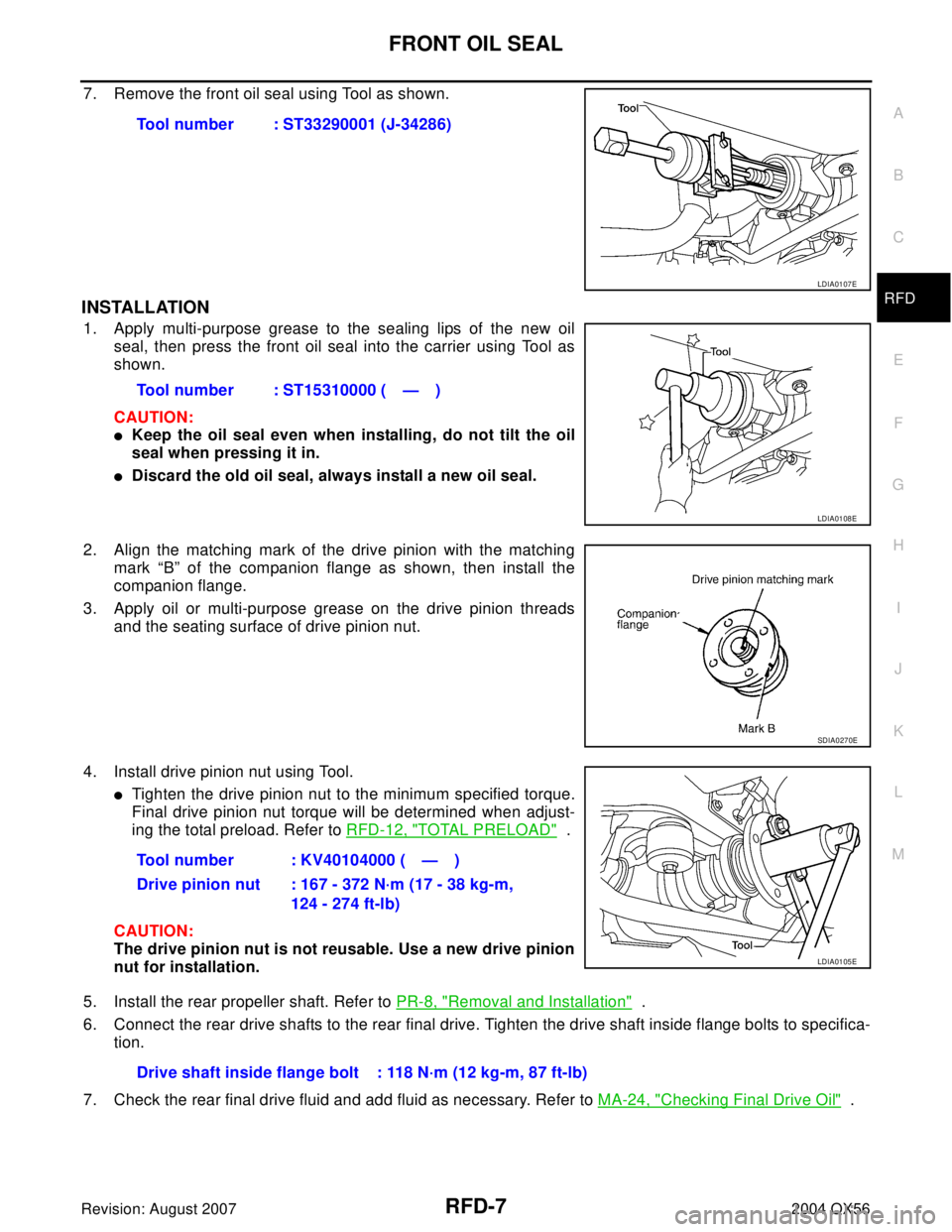
FRONT OIL SEAL
RFD-7
C
E
F
G
H
I
J
K
L
MA
B
RFD
Revision: August 20072004 QX56
7. Remove the front oil seal using Tool as shown.
INSTALLATION
1. Apply multi-purpose grease to the sealing lips of the new oil
seal, then press the front oil seal into the carrier using Tool as
shown.
CAUTION:
�Keep the oil seal even when installing, do not tilt the oil
seal when pressing it in.
�Discard the old oil seal, always install a new oil seal.
2. Align the matching mark of the drive pinion with the matching
mark “B” of the companion flange as shown, then install the
companion flange.
3. Apply oil or multi-purpose grease on the drive pinion threads
and the seating surface of drive pinion nut.
4. Install drive pinion nut using Tool.
�Tighten the drive pinion nut to the minimum specified torque.
Final drive pinion nut torque will be determined when adjust-
ing the total preload. Refer to RFD-12, "
TOTAL PRELOAD" .
CAUTION:
The drive pinion nut is not reusable. Use a new drive pinion
nut for installation.
5. Install the rear propeller shaft. Refer to PR-8, "
Removal and Installation" .
6. Connect the rear drive shafts to the rear final drive. Tighten the drive shaft inside flange bolts to specifica-
tion.
7. Check the rear final drive fluid and add fluid as necessary. Refer to MA-24, "
Checking Final Drive Oil" . Tool number : ST33290001 (J-34286)
LDIA0107E
Tool number : ST15310000 ( — )
LDIA0108E
SDIA0270E
Tool number : KV40104000 ( — )
Drive pinion nut : 167 - 372 N·m (17 - 38 kg-m,
124 - 274 ft-lb)
LDIA0105E
Drive shaft inside flange bolt : 118 N·m (12 kg-m, 87 ft-lb)
Page 2849 of 3371
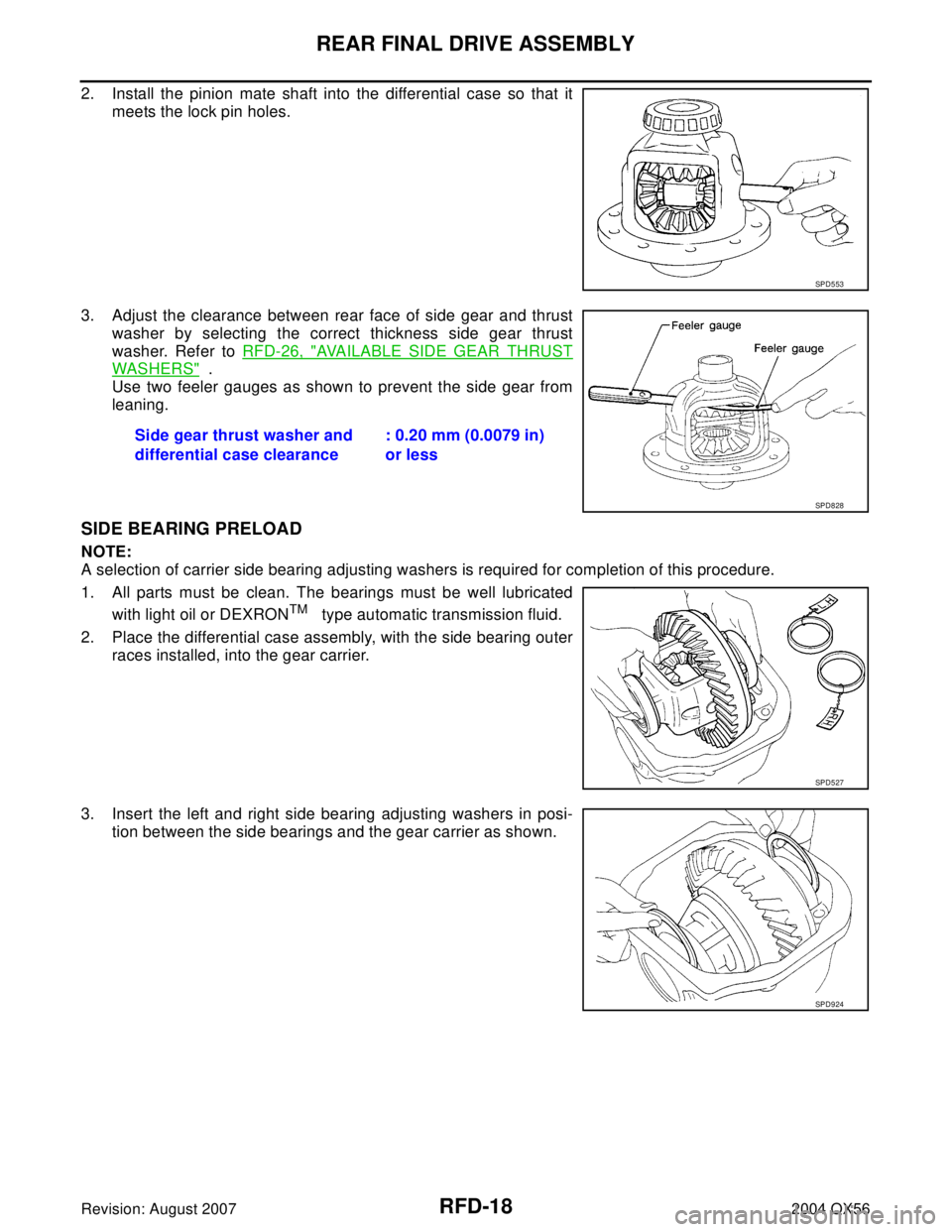
RFD-18
REAR FINAL DRIVE ASSEMBLY
Revision: August 20072004 QX56
2. Install the pinion mate shaft into the differential case so that it
meets the lock pin holes.
3. Adjust the clearance between rear face of side gear and thrust
washer by selecting the correct thickness side gear thrust
washer. Refer to RFD-26, "
AVAILABLE SIDE GEAR THRUST
WAS HER S" .
Use two feeler gauges as shown to prevent the side gear from
leaning.
SIDE BEARING PRELOAD
NOTE:
A selection of carrier side bearing adjusting washers is required for completion of this procedure.
1. All parts must be clean. The bearings must be well lubricated
with light oil or DEXRON
TM type automatic transmission fluid.
2. Place the differential case assembly, with the side bearing outer
races installed, into the gear carrier.
3. Insert the left and right side bearing adjusting washers in posi-
tion between the side bearings and the gear carrier as shown.
SPD5 53
Side gear thrust washer and
differential case clearance: 0.20 mm (0.0079 in)
or less
SPD8 28
SPD5 27
SPD9 24
Page 2925 of 3371
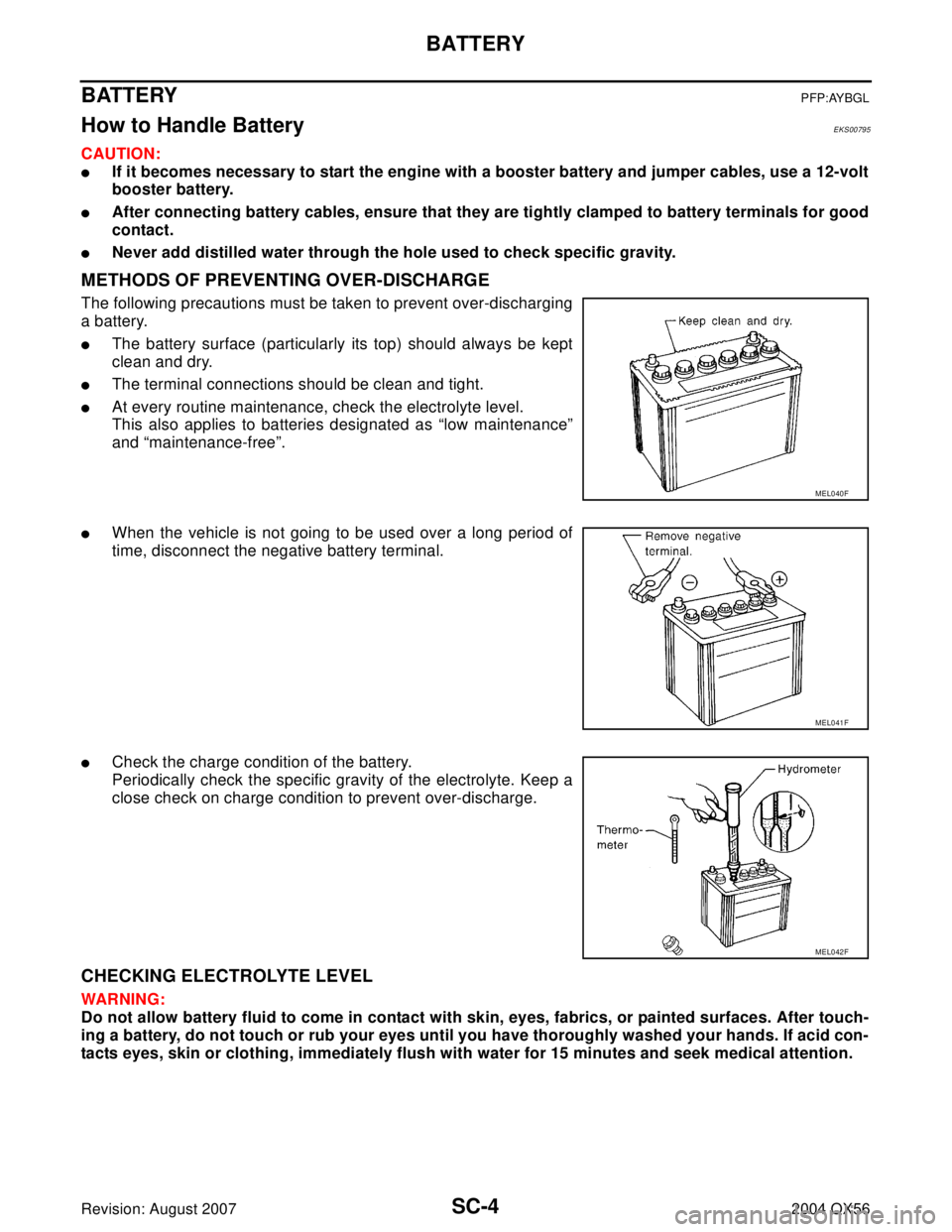
SC-4
BATTERY
Revision: August 20072004 QX56
BATTERYPFP:AYBGL
How to Handle BatteryEKS00795
CAUTION:
�If it becomes necessary to start the engine with a booster battery and jumper cables, use a 12-volt
booster battery.
�After connecting battery cables, ensure that they are tightly clamped to battery terminals for good
contact.
�Never add distilled water through the hole used to check specific gravity.
METHODS OF PREVENTING OVER-DISCHARGE
The following precautions must be taken to prevent over-discharging
a battery.
�The battery surface (particularly its top) should always be kept
clean and dry.
�The terminal connections should be clean and tight.
�At every routine maintenance, check the electrolyte level.
This also applies to batteries designated as “low maintenance”
and “maintenance-free”.
�When the vehicle is not going to be used over a long period of
time, disconnect the negative battery terminal.
�Check the charge condition of the battery.
Periodically check the specific gravity of the electrolyte. Keep a
close check on charge condition to prevent over-discharge.
CHECKING ELECTROLYTE LEVEL
WAR NIN G:
Do not allow battery fluid to come in contact with skin, eyes, fabrics, or painted surfaces. After touch-
ing a battery, do not touch or rub your eyes until you have thoroughly washed your hands. If acid con-
tacts eyes, skin or clothing, immediately flush with water for 15 minutes and seek medical attention.
MEL040F
MEL041F
MEL042F